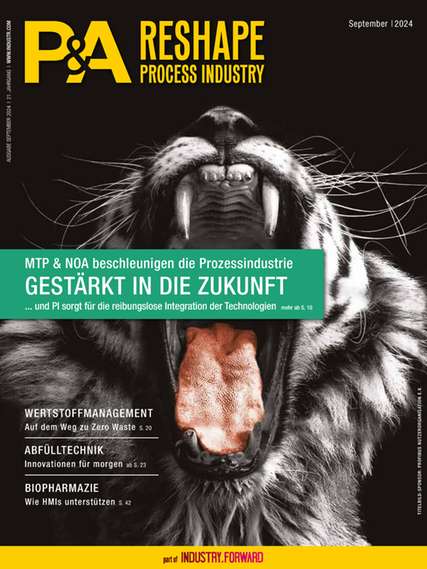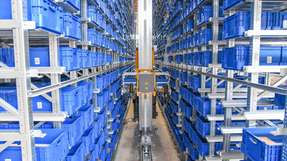For the thermal treatment of waste, the AWG Abfallwirtschaftsgesellschaft Wuppertal operates a waste incineration plant with five incineration lines, four flue gas pre-cleaners, three flue gas post-cleaners and two turbines. The plant has a waste capacity of approx. 400,000 metric tons a year. The planned modernization of the control technology, which had been discontinued by the former control technology supplier, is to be carried out in two stages. In stage 1, the update of the operator control and monitoring level was planned, as well as the integration of the building control and switching technology. The challenge lay in the connection of the various controllers and switching devices which had to be carried out while the plant continued operation.
The availability of the overall system is extremely important, as the failure to adhere to the contracts with the municipalities leads to high contractual penalties and many end consumers depend on district heating. In the worst case, a plant failure is associated with an uncontrolled emission of flue gases, and thus poses a risk to the environment and to health. Furthermore, it was essential that users and/or plant operators quickly and safely adjust to the new system and become familiar with it. In stage 2, the complete automation technology is to be migrated.
In 2015, the Focus Industrieautomation GmbH, a Siemens Solution Partner based in Germany, was awarded the contract for the modernization, and by November 2016 had implemented stage 1 – the replacement of the operator control and monitoring level. Focus changed over the control system during ongoing operations to Simatic PCS 7 with the technology component PCS 7/Open OS from Siemens. To do so, the new system was first 100 percent tested in parallel operation, then half of the operator stations of the old system were replaced by new Simatic PCS 7 OS stations. During a four-week test phase, an intensive system check and the training of the operators took place. Following this, the old system could be switched off and the new PCS 7 control technology was fully put into operation.
The result was an optimal structuring of the new solution, including a transparent documentation and process description. 400 process screens were taken over by the new system. Over 10,000 process objects were transferred into 35 basic types with approximately 250 different derivatives (views). WinCC/ODK (Open Development Kit) could be used to convert all process screens from the previous control system and integrate them into the new system. Since then, about 70,000 process tags are exchanged via the operator control and monitoring system.
The technical implementation in detail
Previously independent systems – such as the discontinued operator control and monitoring system from the former control technology supplier, the building control system from a third-party supplier and the SICAM PAS medium-voltage switching technology – were merged with the Simatic PCS 7 control system. Now, all the information is available to the plant operators in a uniform control system. In the past, different operating philosophies, reporting systems and data structures existed. Today, the new solution makes an identical alarming and uniform operation of the originally individual systems possible.
The new solution is based on virtual technology throughout. In doing so, special attention was paid to high system availability. This, among other things, is ensured by the redundant design of all hardware components such as servers, storage, network infrastructure, time server and uninterruptible power supplies. Additional security is provided by the spatial separation of the redundant system.
By using a virtual cluster, the availability of the operating systems is ensured. Both servers are configured in such a way that in the event of a fault, one server alone can assume control over the entire system. This is made possible through the use of a redundant storage cluster. From the controller to the operator station, the network topology was designed to be highly available. To this end, the networks were functionally separated. For the communication between the servers and the controllers, two autonomous plant bus rings were set up and a total of 21 OPC servers used. The terminal bus for the connection of the operator stations was designed as a double-ring network using Scalance X524 and X204RNA – and thus provides twofold redundancy all the way to the thin client. A Sinema Server monitors the entire network.
Due to the plant structure of the waste incineration plant, two redundant OS server pairs were utilized. The operation takes place on eleven Simatic PCS 7 OS Clients for operators and shift supervisors. Each client possesses four monitors. The six existing large screens in the control room are connected via two Simatic PCS 7 OS Clients. In addition to the virtual Simatic PCS 7 OS Clients, four additional virtual engineering workstations are provided for system maintenance and servicing. Another requirement is the secure access to the control system from the office world. This was made possible via a firewall. The Simatic PCS 7 OS Web Server was installed in a specifically created DMZ (demilitarized zone). The simultaneous access to the Simatic PCS 7 Runtime Viewer by several users takes place via a terminal server.
Customer benefits
The system from Siemens unifies different operating and visualization forms as well as their alarm systems. With Open OS, machine-level controllers from different manufacturers can be seamlessly integrated into Simatic PCS 7 control technology – and thus into a uniform operator control and monitoring system. “The availability greatly increases with PCS 7,” says Wolfgang Krause, AWG maintenance manager and decision-maker on Simatic PCS 7.
The entire, highly complex process must run smoothly 365 days a year, around the clock. The monitoring of all process objects is carried out by the control and monitoring system from Siemens. Each operator monitors up to twelve screens simultaneously. Thanks to the clear representation, which is based on the old system, the plant operator has all the important information in view. New systems and components, regardless of manufacturer, can be integrated at any time and while the plant is in operation. “It was important to us to have an open, flexible system. And that's what we got with Simatic PCS 7 from Siemens”, says Wolfgang Krause.
Future modernization
With stage 1 of the plant modernization barely completed, the next steps have already been implemented. The control engineer of the Focus Industrieautomation integrated the two new ship-container-sized diesel emergency generators with an output of 2 MW each into the Simatic PCS 7 control system.
Furthermore, the first step towards the visualization of the existing district heating system of the neighboring coal and gas power plants has also been already a success. Within the next five to ten years, stage 2 – the modernization of the entire automation technology with AS 410 controllers from Simatic PCS 7 – is to be completed. For preliminary testing, a highly available AS 410 is already in use.
Another redundant Simatic PCS 7 server pair is to follow as early as 2017. While the field level is at present still wired in a conventional way, AWG will put a greater emphasis on bus communication in the future – and thus Profinet/Profibus. The project planners are already in agreement that ET 200 distributed I/O devices will be used for this.













%20Unitechnik%20Systems%20GmbH.jpg)



